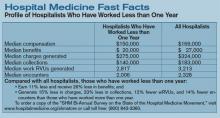The problem of hospital-acquired venous thromboembolism (VTE): Venous thromboembolic disease, ranging from asymptomatic deep vein thrombosis (DVT) to massive pulmonary embolism (PE), is a significant cause of morbidity and mortality in hospitalized patients. Almost all hospitalized patients are at risk for VTE, and the literature suggests that approximately half of all cases of VTE are hospital-acquired.1-4 PE is recognized as the cause of death for more than 100,000 hospitalized patients in the United States every year and is considered a contributing factor in the death of 100,000 more patients.1
Multiple clinical trials have provided irrefutable evidence that primary thromboprophylaxis reduces the incidence of DVT and PE.5 Unfortunately, numerous studies have also shown that the majority of hospitalized patients with risk factors for DVT do not receive appropriate prophylaxis.6-8
Hospitalists are ideally positioned to reduce the incidence of preventable VTE, both by using known best practices to improve care delivered to their own patients, and, more importantly, by leading hospital-wide QI efforts that improve care for all patients at their home institutions.
SHM is now accepting applications for the VTE Prevention Collaborative, a program that offers individualized assistance to hospitalists who wish to take the lead on this critical quality and patient safety issue. Participants can choose the option that best fits their needs: a full year of distance mentoring or a one-day evaluation and consultation visit to their site.
The SHM Mentoring Program
The Mentoring Program is the perfect option for individuals who are interested in securing ongoing support for their planned or active VTE prevention projects. SHM mentors with VTE and QI experts who work with participants to tackle site-specific issues using proven QI techniques. Instruction is organized around the VTE QI Workbook, SHM’s step-by-step guide for developing a VTE prevention program. Mentoring occurs in eight telephone calls scheduled throughout the yearlong mentoring period. During the calls, mentors offer individualized assistance on any topics, tasks, and barriers that are encountered in the course of designing, implementing, and evaluating a VTE prevention project. As needed, participants can also interact with their mentors through e-mail and in ad hoc telephone calls. Participants receive assistance with:
- Securing institutional support for the project;
- Assembling and leading the project team;
- Developing project goals and aims;
- Mapping current processes for assessing VTE risk and bleeding risk;
- Evaluating current prophylaxis recommendations;
- Developing evidence-based risk assessment and prophylaxis recommendations;
- Redesigning care delivery processes to include high-reliability features that promote adherence to best practices;
- Developing educational/outreach plans to ensure buy-in from key stakeholders; and
- Collecting, analyzing, and reporting outcome data.
Individuals with relatively little QI leadership experience, as well as those whose VTE prevention projects are in the early planning stages, are encouraged to apply for the SHM Mentoring Program.
The SHM On-site Consultation Program
The On-site Consultation Program is the perfect option for individuals who are interested in securing expert evaluation and input on a VTE prevention program but don’t feel they need ongoing, longitudinal support. Through the SHM On-site Consultation Program, SHM consultants with VTE and QI expertise visit applicants’ hospitals to evaluate active or planned VTE prevention programs. The visits will be especially helpful to participants who have existing VTE prevention programs they wish to expand or improve upon.
The consultation visits feature a structured evaluation of the site’s strengths and resources, any potential barriers to improvement, and the design and functioning of active or proposed VTE prevention interventions. Specific consultation visit activities will vary according to participant goals and needs but may include meeting with the local project team, QI leaders, hospital administrators, and hospital medicine group leaders, as well as reviewing project documents—order sets, policies, and procedures—data, and data collection/management tools.

